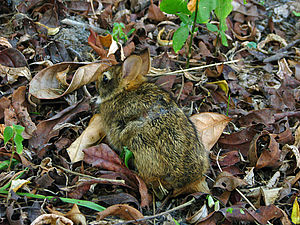Tapeti
| Tapeti | ||||||||||||
|---|---|---|---|---|---|---|---|---|---|---|---|---|

Tapeti ( Sylvilagus brasiliensis ) |
||||||||||||
| Systematics | ||||||||||||
|
||||||||||||
| Scientific name | ||||||||||||
| Sylvilagus brasiliensis | ||||||||||||
| ( Linnaeus , 1758) |
The Tapeti or Brazil Cottontail ( Sylvilagus brasiliensis ) is a sort of the cottontail rabbit ( Sylvilagus ), which in South America to in the northern Argentina is located.
features
The tapeti reaches a head-trunk length of 38 to 42 centimeters, the tail length is 20 to 21 millimeters and the weight is between 500 and 950 grams. The ear length is 50 to 90 millimeters, the hind foot length 77 to 80 millimeters. It is a comparatively small species of cottontail rabbit. Within the distribution area it occurs in about 20 subspecies and accordingly the color characteristics are very variable. The back color ranges from a light gray to an almost monochrome black. The sides of the body and the top of the tail are usually a little lighter than the back color, the underside of the tail is usually sandy brown. The ventral side is usually light gray or white, with a dark throat patch on the throat.
distribution

The tapeti is distributed in numerous subspecies over large parts of South America from Venezuela to northern Argentina. It occurs in forest edge areas as well as in adjacent open areas, whereby it also penetrates into anthropogenically disturbed areas and uses agriculturally used areas.
Way of life
The tapeti is a solitary and nocturnal animal, which can usually be seen especially at dusk or dawn. It is predominantly an inhabitant of the tropical forests, mostly in the area of swamp areas or along rivers, but also in the vicinity of settlements in gardens and parks, and feeds mainly on grasses and leaves.
In contrast to other species, it only gives birth to offspring once a year, the gestation period is longer at six weeks and the litter size at only two is smaller than that of other cottontail rabbits.
Systematics
The Tapeti is classified as an independent species within the genus of cottontail rabbits ( Sylvilagus ). The species was already known to the Swedish scientist Carl von Linné , who scientifically described the tapeti in his Systema naturae and classified it as Lepus brasiliensis . Originally the tapeti also contained the Central American tapeti ( S. gabbi ) and the dice cottontail rabbit ( S. dicei ) , which are now considered to be independent, and it is possible that some of the taxa now considered as subspecies are also separate species.
Within the species, together with the nominate form, there are currently 19 subspecies.
supporting documents
- ↑ a b c Common Tapeto. In: SC Schai-Braun, K. Hackländer: Family Leporidae (Hares and Rabbits) In: Don E. Wilson, TE Lacher, Jr., Russell A. Mittermeier (editor): Handbook of the Mammals of the World: Lagomorphs and Rodents 1. (HMW, Volume 6) Lynx Edicions, Barcelona 2016, pp. 120-121. ISBN 978-84-941892-3-4 .
literature
- Common Tapeti. In: SC Schai-Braun, K. Hackländer: Family Leporidae (Hares and Rabbits) In: Don E. Wilson, TE Lacher, Jr., Russell A. Mittermeier (editor): Handbook of the Mammals of the World: Lagomorphs and Rodents 1. (HMW, Volume 6) Lynx Edicions, Barcelona 2016, pp. 120-121. ISBN 978-84-941892-3-4 .
- Louise H. Emmons, Francois Feer: Neotropical Rainforest Mammals, A Field Guide. 1997,
Web links
- Sylvilagus brasiliensis in the Red List of Threatened Species of the IUCN 2013.1. Listed by: Mexican Association for Conservation and Study of Lagomorphs (AMCELA), Romero Malpica, FJ & Rangel Cordero, H., 2008. Retrieved September 19, 2013.